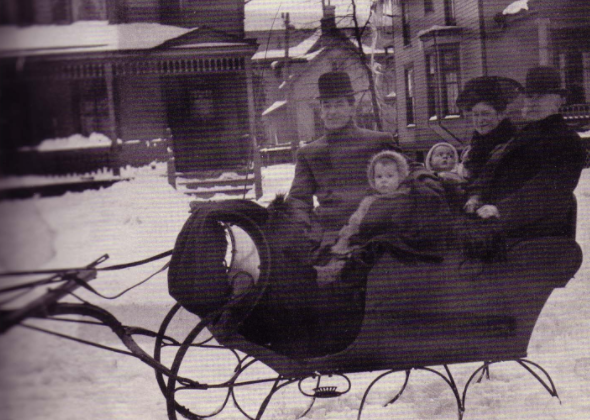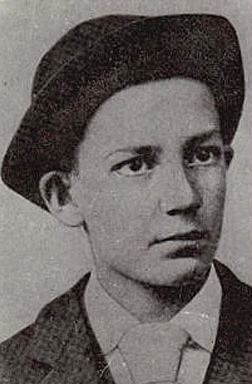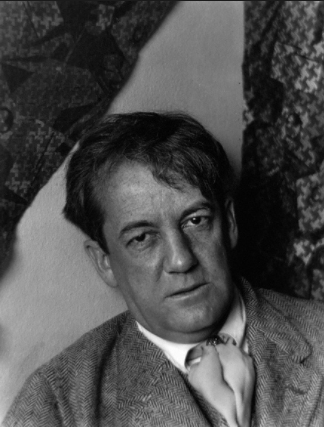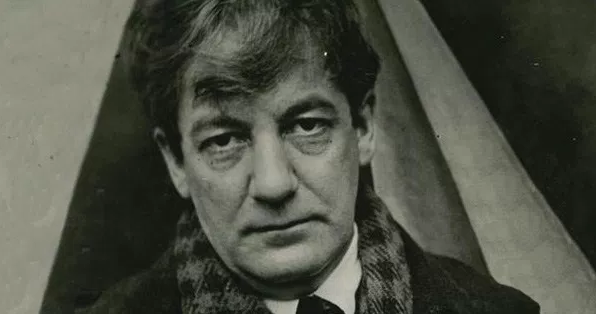
By Margueritte Peterson
As embarrassing as this is to admit, I was first introduced to this great American author through a guilty-pleasure-teenage-girl-TV-show (that shall NOT be named) and began to research him after hearing his works mentioned several times. What I originally thought might turn into a Stephanie Meyer situation (author of Twilight… It was a teenage girl show, after all) actually turned out to be a very serious author of Americana. I read the work he is most often remembered for, Winesburg, Ohio, and immediately understood why he was popular in his time… though was a bit confused as to why I, a Literature Major, had not heard of him as of yet.

Sherwood as a child and his family in rural Ohio.
Sherwood Anderson was born on September 13th, 1876 in Camden, Ohio. The third of seven children, Anderson’s first memories were of the family moving around quite a bit – though spending five or six years in Caledonia, Ohio, most of Anderson’s memories involved his father’s insolvency and inability to hold down a job. The family went from place to place, each time Mr. Anderson losing respectability and finances for his growing family. Because of his family’s difficulties, the young Anderson only completed about 9 months of high school before dropping out at the age of 14 to work various jobs around town in order to bring in money for his family. Despite the lack of advanced schooling, Anderson was an insatiable reader and was consistently borrowing from the local library, as reading was not necessarily a popular past time in the Anderson home.
 By the time Anderson was 18, his father had been drinking and disappearing for weeks at a time, leaving all the children home with their mother to fend for themselves. Having been working desperately for years as a washer, Anderson’s mother Emma died of tuberculosis in 1895 when Anderson was only 19. Having no reason to continue living in the small town of Clyde, Ohio, where the Anderson’s had eventually settled, Sherwood followed his older brother to Chicago, where the two lived in a boarding house as the brother attended the Chicago Art Institute. He continued on in Chicago, eventually renting enough space for his sister and two younger brothers to move into a couple years later. However, having signed up for the Ohio National Guard, his living in Chicago was short-lived, as he was sent to Cuba in 1898, after the fighting in the Spanish-American War had stopped, for 8 months. After his return, Anderson worked in Clyde once more for a few months as he saved money, and eventually joined two of his siblings in Springfield, Ohio, where finally, at the age of 23, Anderson enrolled in classes and was able to complete his high school education.
By the time Anderson was 18, his father had been drinking and disappearing for weeks at a time, leaving all the children home with their mother to fend for themselves. Having been working desperately for years as a washer, Anderson’s mother Emma died of tuberculosis in 1895 when Anderson was only 19. Having no reason to continue living in the small town of Clyde, Ohio, where the Anderson’s had eventually settled, Sherwood followed his older brother to Chicago, where the two lived in a boarding house as the brother attended the Chicago Art Institute. He continued on in Chicago, eventually renting enough space for his sister and two younger brothers to move into a couple years later. However, having signed up for the Ohio National Guard, his living in Chicago was short-lived, as he was sent to Cuba in 1898, after the fighting in the Spanish-American War had stopped, for 8 months. After his return, Anderson worked in Clyde once more for a few months as he saved money, and eventually joined two of his siblings in Springfield, Ohio, where finally, at the age of 23, Anderson enrolled in classes and was able to complete his high school education.
Upon his graduation in 1900, Anderson was one of seven students in his graduating class chosen to give commencement speeches. One observer of his speech, Harry Simmons, was an advertising manager for a publishing house. Simmons was so impressed with the speech that he offered him a job as an advertising solicitor right then and there. In the summer of 1900, Anderson went back to Chicago to begin work for the type of business he would work in for the next 6 years.
 One important aspect often noted in Anderson’s life is the nervous breakdown he suffered as a result of professional stress in 1912. By this time, he had begun a new business called the Anderson Paint Company. The intensity of running his own (large) business took its toll and Anderson disappeared for four days, before walking into a drug store and asking an employee to help him figure out his own identity. To this day, it is uncertain as to whether Anderson’s breakdown was involuntary or voluntary, as his story changed over the months and years following the episode. Either way, however, it helped Anderson leave his business, his relationship, and start fresh. Anderson had begun publishing some stories in 1902, and soon writing would become his main source of income.
One important aspect often noted in Anderson’s life is the nervous breakdown he suffered as a result of professional stress in 1912. By this time, he had begun a new business called the Anderson Paint Company. The intensity of running his own (large) business took its toll and Anderson disappeared for four days, before walking into a drug store and asking an employee to help him figure out his own identity. To this day, it is uncertain as to whether Anderson’s breakdown was involuntary or voluntary, as his story changed over the months and years following the episode. Either way, however, it helped Anderson leave his business, his relationship, and start fresh. Anderson had begun publishing some stories in 1902, and soon writing would become his main source of income.
Anderson’s first novel, Windy McPherson’s Son, was published in 1916, followed shortly thereafter by Marching Men, published in 1917. However, in 1919 he would publish the work he would remain famous for, a collection of interrelated short stories of residents in a small Ohio town – the book Winesburg, Ohio. The book was a success, as researcher Daniel Mark Fogel writes that Anderson, “Instead of emphasizing plot and action, Anderson used a simple, precise, unsentimental style to reveal the frustration, loneliness, and longing in the lives of his characters. These characters are stunted by the narrowness of Midwestern small-town life and by their own limitations.” For what seemed like the first time, an author focused very little on plot and much more on character development than any other aspect of stories. Anderson continued publishing novels, despite the success of his book of short stories. He published his novels Poor White and Many Marriages in the 20s while living in New Orleans with his third wife, while entertaining and influencing other famous writers in the United States.

Throughout the 30s, Anderson published many different kinds of works. A book of short stories, Death in the Woods, a book of essays entitled Puzzled America and a novel called Kit Brandon: A Portrait. Though he still experienced some success and notoriety, his public persona had begun to wane and he was no longer quite as influential as he once was. He continued writing until his death in 1941. His death was just as different as his nervous breakdown, interestingly enough. On a cruise to Panama, Anderson began experiencing abdominal pain and succumbed to a strange infection before he was even able to return to the United States. An autopsy revealed that he had swallowed a martini toothpick, which had perforated his intestines and caused an infection to spread throughout his body. A strange death following an interesting life of a little known but quite influential American author!

